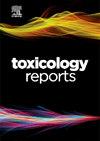Digoxin toxicity with therapeutic serum digoxin concentrations
Q1 Environmental Science
引用次数: 0
Abstract
Introduction
Digoxin is a cardiac glycoside used for rate control in atrial fibrillation and heart failure. Despite its efficacy, digoxin has a narrow therapeutic window and can cause severe side effects, including life-threatening arrhythmias. Literature and guidelines on management of digoxin toxicity remain inconsistent whether to include serum digoxin concentrations as a key criterium for diagnosing digoxin toxicity and determining the indication for digoxin-specific antibody fragments. This report presents a case of digoxin toxicity at therapeutic serum concentrations.
Case report
A 76-year-old male presented with bradycardia, hyperkalemia, and acute kidney injury following gastrointestinal bleeding. Despite serum digoxin concentrations within the therapeutic range (1.4 ng/ml), the patient exhibited symptoms consistent with severe digoxin toxicity. Initial treatments, including calcium gluconate, insulin-glucose, and sodium bicarbonate, failed to resolve hyperkalemia and/or bradycardia. Administration of 40 mg digoxin-specific antibody fragments led to rapid normalization of potassium levels, improved heart rate, and hemodynamic stabilization, indicative for severe digoxin toxicity despite therapeutic serum concentrations.
Discussion
This case demonstrates that digoxin toxicity can occur at serum concentrations in therapeutic range, emphasizing the importance of clinical features in diagnosing digoxin toxicity. Current guidelines vary on the role of serum digoxin concentrations in guiding the use of digoxin-specific antibody fragments, but this case underscores its efficacy in resolving symptoms related to digoxin toxicity, even at low serum concentrations.
地高辛毒性与治疗血清地高辛浓度有关
地高辛是一种心脏糖苷,用于房颤和心力衰竭的心率控制。尽管地高辛疗效显著,但它的治疗窗口很窄,并可能导致严重的副作用,包括危及生命的心律失常。地高辛毒性管理的文献和指南在是否将血清地高辛浓度作为诊断地高辛毒性和确定地高辛特异性抗体片段适应症的关键标准方面存在不一致。本报告提出一例地高辛毒性在治疗血清浓度。病例报告一名76岁男性,表现为心动过缓、高钾血症和胃肠道出血后急性肾损伤。尽管血清地高辛浓度在治疗范围内(1.4 ng/ml),但患者表现出与严重地高辛毒性相符的症状。最初的治疗,包括葡萄糖酸钙、胰岛素-葡萄糖和碳酸氢钠,未能解决高钾血症和/或心动过缓。给予40 mg地高辛特异性抗体片段导致钾水平迅速正常化,心率改善和血流动力学稳定,表明尽管治疗血清浓度较高,但地高辛毒性严重。本病例表明地高辛毒性可发生在治疗范围内的血清浓度,强调临床特征对地高辛毒性诊断的重要性。目前的指南对地高辛血清浓度在指导使用地高辛特异性抗体片段方面的作用有所不同,但本病例强调了其在解决地高辛毒性相关症状方面的有效性,即使在低血清浓度下也是如此。
本文章由计算机程序翻译,如有差异,请以英文原文为准。
求助全文
约1分钟内获得全文
求助全文
来源期刊

Toxicology Reports
Environmental Science-Health, Toxicology and Mutagenesis
CiteScore
7.60
自引率
0.00%
发文量
228
审稿时长
11 weeks
 求助内容:
求助内容: 应助结果提醒方式:
应助结果提醒方式:


